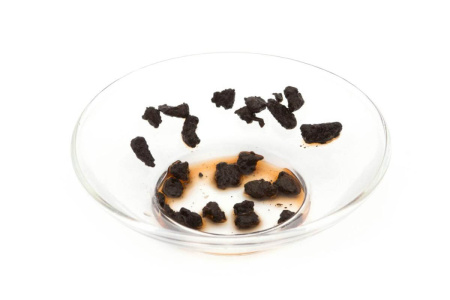-
8 Saturation
-
8 Aftertaste
-
7 Aroma
-
8 Effect
-
9 Balance
-
7 Body
Ча хуа ши (кит.茶化石, пиньин Cháhuàshí ) – это один из сортов высококачественного пуэра с древних деревьев, создается путем синтеза традиционной и современной обработки сырья. Продукт впервые выпущен и запатентован чайной компанией Лунюань (кит. 龙园茶业,Lóngyuáncháyè). Для его производства подходят только весенние листья и почки c деревьев возрастом более 100 лет из района Мэнхай, которые проходят сложный процесс производства. Поэтому Чахуа - продукт довольно редкий. По форме и размеру разделяют: Чахуаши (кит.茶化石, пиньин Cháhuàshí) - чайные окаменелости, Суйинцзы (кит. 碎银子, пиньин Suìyínzi)– дословно переводится «серебряная монета» и др.
В процессе ферментации чайный лист выделяет пектин, который крепко склеивает чайные листья вместе. Слипшиеся кусочки вынимают из общей массы пуэра, так как во время хранения чайные кусочки становятся все более плотными. Из-за формы такие окаменелости называют «разменное серебро», ведь по форме они напоминают древние деньги. В последнее время названия суйинцзы и чахуаши стали использоваться к чайным головам малого и среднего размера. Фактически чайные окаменелости относятся к типу пуэра чайные головы, но более высокого качества, т.к. ферментированные куски шу пуэра подвергаются дополнительной обработке. Можно сказать они лучшие образцы чайных голов, которые выдерживают до 30 проливов.
Процесс производства чайных окаменелостей включает 36 этапов длительностью около года. Именно столько требуется времени, чтобы создать идеальный продукт. Чай проходит ферментацию 3 раза. На первом этапе отбирают превосходное сырье, в процессе ферментации дают пектину склеивать листья, это создает густой насыщенный аромат. На втором этапе происходит дозревание, на третьем появляется особый аромат, который свидетельствует о готовности.
Про этот продукт говорят: «Не попробовав Чахуаши, как смеешь говорить, что понимаешь пуэры». По характеру напиток из них теплый, благоприятно сказывающийся на пищеварении. Его длительное употребление улучшает работу желудка, способствует похудению, снижению давления, сахара и холестерина в крови, применяется для профилактики коронарной болезни сердца и атеросклероза, оказывает антибактериальное и противовоспалительное действие. Подходит для употребления лицам среднего и пожилого возраста, особенно со слабостью (холодом) желудка. Кроме того в процессе ферментации чай обогащается пробиотиками и имеет высокую пищевую ценность.
Форма настоящего чахуаши округлая и гладкая, цвет коричневый или темно коричневый, блестящий и однородный, без следов плесени, высокой плотности, без прочих примесей. Высококачественный продукт имеет ярко выраженный запах чая пуэр и легкий аромат клейкого риса. Подделки как правило имеют сильный аромат риса и почти не имеют аромат чая, либо имеют затхлый запах.
Cha Hua Shi (Tea fossil) is a rather interesting and noteworthy product. It is a new, modern variety of Shu Puer. Unlike Lao Cha Tou (old tea heads), tea fossil has denser lumps of small size, homogeneous mass, in which there is no tea leaf as such.
When dry, they have a very bright, juicy aroma of brewed black tea with village milk and Chinese sweets made from sticky rice. After washing the fossils, the aroma only intensifies, becoming deeper. Shades of sweet sticky rice become more noticeable.
The taste of Cha Hua Shi is smooth, restrained, without defects, with a sweetish shade of sticky rice and hot baked milk. Tea fossils are able to withstand an incredible number of steepings - up to 20. Having brewed 7 grams of tea in a 150 ml porcelain gaiwan, the taste began to retreat only after 17 steepings! Neat woody, sweetish notes appeared. The color of the resulting infusion is red-brown, deep, as the steepings increase it turns into copper-brown. The infusion is very transparent and clean.
The aftertaste is long-lasting, sweetish, with a hint of nuts in sugar glaze. The recommended utensils for brewing this tea are a gaiwan or clay teapot.
Cha Hua Shi has a very soft tonic effect, helps to collect thoughts, relax. The tea is very easy to drink, does not irritate the stomach. For those who like to brew tea in a thermos, Cha Hua Shi tea fossils are an excellent option.
|
Name in Chinese
|
茶化石 |
|
Pinyin
|
cháhuàshi |
|
Country
|
China |
- Reviews
- Vkontakte
Pu-erh is one of the most unique types of tea, which only gets better with age. Many people, when they first encounter this tea, wondered: why is pu-erh more often found in pressed form (cakes, bricks, tochas), and not in loose form? The reasons for this are related to both history and the practical aspects of storing and fermenting tea. Despite modern technologies that allow the production of loose pu-erh, the shape of pressed cakes remains unchanged. And pu-erh is more often found on sale in pressed form, for example, in the form of cakes or bricks, and loose pu-erh is less common. We will talk about the reasons for pressing pu-erh into cakes in this article.
Puer is a unique Chinese tea that is distinguished by its depth of taste, complexity of aromas and versatility of aftertaste. Its taste characteristics are formed under the influence of many factors, from growing conditions to the brewing method. Let's look at the main ones.





















































































